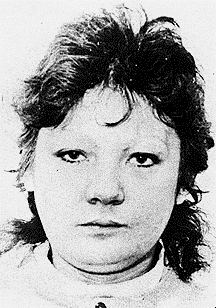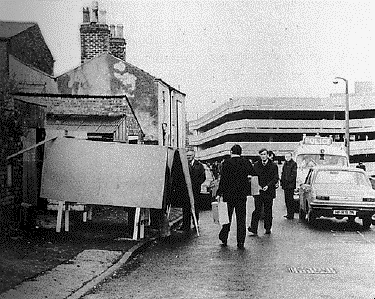

| AGE | DATE | PLACE | OUTCOME |
|---|---|---|---|
| 26 | November 20 1975 Thursday night 10:30 pm | Preston | Murdered |
The two letters posted in March 1978, one to George Oldfield, and the other to the Manchester offices of the Daily Mirror, both claimed that the police had the number of Yorkshire Ripper victims wrong. The letters stated "Up to number 8 now you say 7 but remember Preston '75", a reference to the Joan Harrison murder.
Joan Harrison, age 26, a native of Chorley, and living apart from her husband and daughters for about two years, often looked 20 years older than her age due to her chronic alcoholism. Her health was deteriorating rapidly, and she was also hooked on morphine contained in cough mixtures, which she had been known to consume at the rate of eight bottles a day. She had close associations with other alcoholics, drug addicts, and prostitutes in the Preston area. While she did not have any convictions for prostitution, it was know that she would take money for sex in order to feed her drinking habit. In 1974, she plead guilty to stealing and to forging a drug prescription in an appearance at Preston Magistrates Court. During the case, she was described as "a complete wreck of a human being."
In July 1975, Joan Harrison, unemployed and living on social security, began renting a room in the Avenham Street area of Preston from landlord David Keighley. The two began a relationship, David Keighley trying to give her a stable home life and show a better side of life, but fighting a losing battle with her alcoholism, which sometimes resulted in binges where she would associate with the winos on skid row. David Keighley said they were engaged to be married and he had bought her a ring.
On Thursday, November 20 1975, Joan Harrison spent most of the day at the St Mary's Hostel for homeless men, having a voluntary job as a part-time cleaner where she helped out with the washing up. According to Ian Pinchen, the hostel's warden, Joan Harrison set off with some of the hostel's staff at lunchtime for a drink at the nearby St Mary's pub. She came back drunk after the afternoon closing time, and was allowed to lie down on one of the rest beds. Shortly after 4:00 pm she had sexual intercourse with a man at the hostel.
It wasn't until around 10:00 pm before she was sober enough to return to her own home. When David Keighley refused to give her any money for more drink, Joan Harrison angrily left her home at around 10:20 pm, walking along Church Street towards the Preston town centre, wearing a light green three quarter-length coat with an imitation fur collar, turquoise-blue jumper with a bright yellow tank-top over it, dark brown trousers, and brown suede calf-length boots.'

At around 8:00 am on Sunday, November 23 1975, shortly after her husband Ronald had left for work, Mrs Mildred Atkinson left her home on Guildford Road to go to the newsagents to get the Sunday papers. As she walked along Berwick Road, at the rear of No. 3 Frenchwood Street, which had been recently sold to the council and had been vacant for a month, she noticed that the door on a derelict lock-up garage on the property was flapping and banging in the wind. When the door blew open she saw a body lying face down on the concrete floor in the garage, a coat over its head, and blood on the ground beside it. Her first thoughts were that it might have been a drunken man who had banged his head. In reality, she had discovered the body of the murdered Joan Harrison.
Lying face down, Joan Harrison had been moved a few feet from where the initial attack had happened. Her trousers were pulled down and one leg was out of her pants and tights, and one of her boots had been removed. Before her coat had been placed over the body, the boot that had been removed had been placed over her leg so that it appeared to be worn. She had been wearing two padded bras, both had been lifted up to expose her breasts, but one of the bras, which had been unfastened, had slipped down again.
The post-mortem was carried out at Preston Royal Infirmary by pathologist Dr John Benstead, who was unable to determine either the exact cause of death, or pinpoint the time of death. The cause of death given on the death certificate was: "haemorrhage and shock caused by multiple injuries, murder by person or persons unknown". Joan Harrison had one u-shaped laceration on the back of her head. The Lancashire police concluded that she had been hit with the heel of a lady's shoe, though none was found, and Joan Harrison had been wearing boots. Later it was thought that the injury could have been consistent with an attempt to hit her with a hammer. There were also extensive injuries to her head, face, body, and legs, which it was concluded had been caused by violent kicking and stamping. There were no stab wounds.
There were also bite marks on Joan Harrison's left breast, which were examined by Liverpool dentist, James Furness, a specialist in forensic odontology, who was fond of saying, "People can lie through their teeth, but their teeth cannot lie." He concluded that the marks on the breast had been put there a short time before death, and that the bruising indicated a clear gap in the front upper teeth.
Pathological examination of the body also found semen deposits, apparently due to vaginal and anal intercourse, and at around the time of death. Approximately 80 per of the population secrete blood-cells into body fluids like semen and saliva. It was established that the semen came from one of about six per cent of the male population that belonged to blood group B. The man at the hostel who had had sexual intercourse with Joan Harrison had blood group A. The Lancashire police took saliva samples from over six thousand men, including friends and acquaintances, those in the Avenham area of town and its environs, crews from ships that had been at the Preston docks at around the time of the murder, etc.
The police also discovered that Joan Harrison's handbag and purse were also missing. Joan Harrison's handbag was thought to include such items as cigarette lighters, rings, bracelets, an inhaler used by asthmatics, and possibly a diary, although without many detailed entries. Lancashire police believed that the murderer was a local familiar with the area. The police believed they had further confirmation of this when her purse was found two months later hidden in a bush in Avenham Park, and in June 1976 when her handbag was found carefully hidden in a refuse-tip about 400 yards from where she was killed.
The murder of Joan Harrison was not felt by the Lancashire police to be connected to, what eventually would be known as the first Yorkshire Ripper murder, the murder of Wilma McCann the previous month. It was after Irene Richardson was murdered in 1977, with the similar arrangement of boots placed over the legs to make them appear to still be worn, and the covering of the body with a coat, that the Lancashire and Yorkshire police thought there might be a possible connection to the series, but because of the obvious sexual assault and robbery, elements missing from the Yorkshire Ripper attacks, the murder of Joan Harrison was not conclusively linked. It was the letters and tape, including the forensic evidence from them, which would finally cause the Joan Harrison murder to, wrongly and tragically, be linked to the Yorkshire Ripper.
(NOTE: Source: Cross, Lavelle, Nicholson, Yallop, The Sunday Times, New Statesman. Photo source: Yallop.)